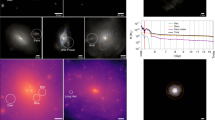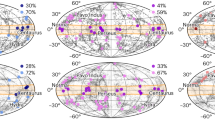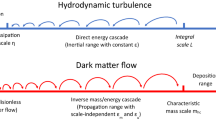Abstract
Dark matter is currently one of the main mysteries of the Universe. There is much strong indirect evidence that supports its existence, but there is yet no sign of a direct detection1,2,3. Moreover, at the scale of galaxies, there is tension between the theoretically expected dark matter distribution and its indirectly observed distribution4,5,6,7. Therefore, phenomena associated with dark matter have a chance of serving as a window towards new physics. The radial acceleration relation8,9 confirms that a non-trivial acceleration scale a0 can be found from the internal dynamics of several galaxies. The existence of such a scale is not obvious as far as the standard cosmological model is concerned10,11, and it has been interpreted as a possible sign of modified gravity12,13. Here, we consider 193 high-quality disk galaxies and, using Bayesian inference, show that the probability of existence of a fundamental acceleration is essentially 0: the null hypothesis is rejected at more than 10σ. We conclude that a0 is of emergent nature. In particular, the modified Newtonian dynamics theory14,15,16,17—a well-known alternative to dark matter based on the existence of a fundamental acceleration scale—or any other theory that behaves like it at galactic scales, is ruled out as a fundamental theory for galaxies at more than 10σ.
This is a preview of subscription content, access via your institution
Access options
Access Nature and 54 other Nature Portfolio journals
Get Nature+, our best-value online-access subscription
$29.99 / 30 days
cancel any time
Subscribe to this journal
Receive 12 digital issues and online access to articles
$119.00 per year
only $9.92 per issue
Buy this article
- Purchase on Springer Link
- Instant access to full article PDF
Prices may be subject to local taxes which are calculated during checkout


Similar content being viewed by others
References
Akerib, D. S. et al. Results from a search for dark matter in the complete LUX exposure. Phys. Rev. Lett. 118, 021303 (2017).
Aprile, E. et al. First dark matter search results from the XENON1T experiment. Phys. Rev. Lett. 119, 181301 (2017).
Liu, J., Chen, X. & Ji, X. Current status of direct dark matter detection experiments. Nat. Phys. 13, 212–216 (2017).
Mo, H., van den Bosch, F. & White, S. Galaxy Formation and Evolution (Cambridge Univ. Press, Cambridge, 2010).
Del Popolo, A. & Le Delliou, M. Small scale problems of the ΛCDM model: a short review. Galaxies 5, 17 (2017).
Bullock, J. S. & Boylan-Kolchin, M. Small-scale challenges to the ΛCDM paradigm. Ann. Rev. Astron. Astrophys. 55, 343–387 (2017).
Rodrigues, D. C., del Popolo, A., Marra, V. & de Oliveira, P. L. C. Evidences against cuspy dark matter halos in large galaxies. Mon. Not. R. Astron. Soc. 470, 2410–2426 (2017).
McGaugh, S., Lelli, F. & Schombert, J. Radial acceleration relation in rotationally supported galaxies. Phys. Rev. Lett. 117, 201101 (2016).
Li, P., Lelli, F., McGaugh, S. & Schormbert, J. Fitting the radial acceleration relation to individual SPARC galaxies. Preprint at https://arxiv.org/abs/1803.00022 (2018).
Ludlow, A. D. et al. Mass-discrepancy acceleration relation: a natural outcome of galaxy formation in cold dark matter halos. Phys. Rev. Lett. 118, 161103 (2017).
Navarro, J. F. et al. The origin of the mass discrepancy–acceleration relation in ΛCDM. Mon. Not. R. Astron. Soc. 471, 1841 (2017).
Lelli, F., McGaugh, S. S., Schombert, J. M. & Pawlowski, M. S. One law to rule them all: the radial acceleration relation of galaxies. Astrophys. J. 836, 152 (2017).
Smolin, L. MOND as a regime of quantum gravity. Phys. Rev. D96, 083523 (2017).
Milgrom, M. A modification of the Newtonian dynamics—implications for galaxies. Astrophys. J. 270, 371–389 (1983).
Sanders, R. H. & McGaugh, S. S. Modified Newtonian dynamics as an alternative to dark matter. Ann. Rev. Astron. Astrophys. 40, 263–317 (2002).
Famaey, B. & McGaugh, S. Modified Newtonian dynamics (MOND): observational phenomenology and relativistic extensions. Living Rev. Rel. 15, 10 (2012).
Milgrom, M. Road to MOND: a novel perspective. Phys. Rev. D92, 044014 (2015).
Famaey, B. & Binney, J. Modified Newtonian dynamics in the Milky Way. Mon. Not. R. Astron. Soc. 363, 603–608 (2005).
Gentile, G., Famaey, B. & de Blok, W. THINGS about MOND. Astron. Astrophys. 527, A76 (2011).
Hees, A., Famaey, B., Angus, G. W. & Gentile, G. Combined Solar System and rotation curve constraints on MOND. Mon. Not. R. Astron. Soc. 455, 449–461 (2016).
De Blok, W. J. G. & McGaugh, S. S. Testing modified Newtonian dynamics with low surface brightness galaxies: rotation curve FITS. Astrophys. J. 508, 132–140 (1998).
McGaugh, S. S., Schombert, J. M., Bothun, G. D. & de Blok, W. The baryonic Tully–Fisher relation. Astrophys. J. 533, L99–L102 (2000).
Dodelson, S. The real problem with MOND. Int. J. Mod. Phys. D20, 2749–2753 (2011).
Sanders, R. H. Clusters of galaxies with modified Newtonian dynamics (MOND). Mon. Not. R. Astron. Soc. 342, 901 (2003).
Angus, G. W. Are sterile neutrinos consistent with clusters, the CMB and MOND? Mon. Not. R. Astron. Soc. 394, 527 (2009).
Milgrom, M. Bimetric MOND gravity. Phys. Rev. D80, 123536 (2009).
Babichev, E., Deffayet, C. & Esposito-Farese, G. Improving relativistic MOND with Galileon k-mouflage. Phys. Rev. D84, 061502 (2011).
Verlinde, E. P. Emergent gravity and the Dark Universe. SciPost Phys. 2, 016 (2017).
Iocco, F., Pato, M. & Bertone, G. Testing modified Newtonian dynamics in the Milky Way. Phys. Rev. D92, 084046 (2015).
Randriamampandry, T. & Carignan, C. Galaxy mass models: MOND versus dark matter haloes. Mon. Not. R. Astron. Soc. 439, 2132–2145 (2014).
Lelli, F., McGaugh, S. S. & Schombert, J. M. SPARC: mass models for 175 disk galaxies with Spitzer photometry and accurate rotation curves. Astron. J. 152, 157 (2016).
Walter, F. et al. THINGS: the HI Nearby Galaxy Survey. Astron. J. 136, 2563–2647 (2008).
De Blok, W. J. G. et al. High-resolution rotation curves and galaxy mass models from THINGS. Astron. J. 136, 2648–2719 (2008).
Famaey, B., Khoury, J. & Penco, R. Emergence of the mass discrepancy–acceleration relation from dark matter–baryon interactions. J. Cosmol. Astropart. Phys. 1803, 038 (2018).
Acknowledgements
We thank S. McGaugh for clarifications regarding the SPARC sample and comments on a previous version of this paper. This work made use of SPARC (Spitzer Photometry & Accurate Rotation Curves) and of THINGS (The HI Nearby Galaxy Survey). D.C.R. and V.M. thank CNPq and FAPES for partial financial support. A.d.P. was supported by the Chinese Academy of Sciences and its President’s International Fellowship Initiative (grant number 2017 VMA0044). Z.D. thanks the Ministry of Science, Research and Technology of Iran for financial support.
Author information
Authors and Affiliations
Contributions
D.C.R. and A.d.P. proposed the study. D.C.R. developed the MAGMA package, performed the χ2 minimization analysis, and contributed to interpretation and design. V.M. developed the mBayes package, performed the Bayesian analysis, and contributed to interpretation and design. Z.D. carried out the THINGS sample analysis and raised issues that were essential for the beginning of this project. The first draft was written by D.C.R. and V.M., and all the authors contributed to its development.
Corresponding authors
Ethics declarations
Competing interests
The authors declare no competing interests.
Supplementary information
Supplementary Information
Supplementary Figures 1–7, Supplementary Tables 1–3
Rights and permissions
About this article
Cite this article
Rodrigues, D.C., Marra, V., del Popolo, A. et al. Absence of a fundamental acceleration scale in galaxies. Nat Astron 2, 668–672 (2018). https://doi.org/10.1038/s41550-018-0498-9
Received:
Accepted:
Published:
Issue Date:
DOI: https://doi.org/10.1038/s41550-018-0498-9
This article is cited by
-
Quantum Modified Gravity at Low Energy in the Ricci Flow of Quantum Spacetime
International Journal of Theoretical Physics (2023)
-
Overconfidence in Bayesian analyses of galaxy rotation curves
Nature Astronomy (2020)
-
Reply to: Overconfidence in Bayesian analyses of galaxy rotation curves
Nature Astronomy (2020)
-
Presence of a fundamental acceleration scale in galaxies
Nature Astronomy (2018)
-
A common Milgromian acceleration scale in nature
Nature Astronomy (2018)



